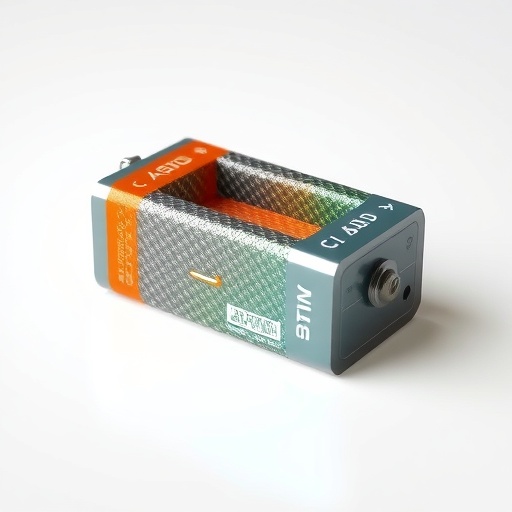In recent years, the demand for efficient energy storage systems has skyrocketed due to the rapid advancements in portable electronics and electric vehicles. Traditional batteries often fall short in performance, leading researchers to explore alternative energy storage solutions. One promising avenue is the development of supercapacitors, especially asymmetric types that combine the strengths of capacitors and batteries. A recent study by Hao and Hong has made significant strides in this direction, presenting a novel fabrication method for asymmetric supercapacitors utilizing N-doped porous carbon and structure-modified Ti3C2Tx MXene.
Supercapacitors, also known as ultracapacitors, are energy storage devices that bridge the gap between conventional capacitors and rechargeable batteries. They offer high power density and fast charge/discharge capabilities, making them ideal for applications requiring quick bursts of energy. However, their energy density has often been a limiting factor compared to batteries. This newly proposed asymmetric supercapacitor design aims to enhance energy density while maintaining the desirable power characteristics that supercapacitors are known for.
At the core of Hao and Hong’s research lies the innovative use of N-doped porous carbon, which has emerged as a highly efficient electrode material. Nitrogen doping significantly improves the electrochemical performance of carbon materials by enhancing conductivity and increasing the number of active sites available for charge storage. This modification allows the carbon structure to hold more charge, thus boosting the overall energy density of the supercapacitor.
In conjunction with N-doped porous carbon, the study also highlights the integration of structure-modified Ti3C2Tx MXene, a material renowned for its excellent electrical conductivity and mechanical properties. MXenes are a family of two-dimensional materials that have captured the attention of researchers due to their versatility and efficiency in energy storage applications. The modification of Ti3C2Tx involves tuning its structure to optimize interactions with the surrounding electrolyte, further enhancing the performance of the supercapacitor.
The fabrication process of this asymmetric supercapacitor is notably straightforward, which stands as an essential factor for scalability and industrial application. Hao and Hong demonstrate that a simple yet effective synthesis method yields materials that not only meet but exceed the required performance metrics for energy storage devices. This efficiency does not come at the cost of complexity, making it an attractive option for future development in clean energy technology.
Additionally, the researchers conducted a battery of tests to analyze the electrochemical performance of their fabricated supercapacitor. Through cyclic voltammetry, galvanostatic charge-discharge tests, and impedance spectroscopy, they were able to assess key parameters such as energy density, power density, and cycle life. The results indicated substantial improvements, showcasing the potential of the N-doped porous carbon and Ti3C2Tx MXene hybrid for practical applications in energy storage.
The implications of this research extend beyond supercapacitors themselves. The novel materials and fabrication techniques presented in this study could potentially influence the development of other advanced energy systems, including hybrid batteries and capacitors. By laying the groundwork for high-performance, scalable, and cost-effective energy storage solutions, Hao and Hong’s research represents a significant step toward the realization of sustainable energy technologies.
Moreover, the scalability of this fabrication method could contribute to mass production efforts. As the world continues to shift toward more sustainable forms of energy, there is a pressing need for energy storage solutions that can be readily produced and deployed. The findings from this research may pave the way for commercial applications, accelerating the transition to electric vehicles, renewable energy storage, and portable electronic devices.
As the research community continues to explore innovative materials and structures, it is important to recognize the collaborative nature of such advancements. The synthesis of N-doped porous carbon and the modification of Ti3C2Tx MXene rely on a multitude of previous works, demonstrating the richness and interconnectedness of material science research. It is through such interdisciplinary efforts that breakthroughs in energy storage technologies are made possible, pushing the boundaries of what is achievable.
The findings from Hao and Hong’s study are not only pivotal for further theoretical exploration but also serve as a practical guide for engineers and technologists in the field. As the energy landscape evolves, understanding the nuances of material properties, fabrication techniques, and performance metrics becomes essential for the development of next-generation energy solutions.
In conclusion, the innovative asymmetric supercapacitor design based on N-doped porous carbon and structure-modified Ti3C2Tx MXene represents not just a technical achievement, but a forward-thinking approach to addressing one of the critical challenges of energy storage today. As researchers continue to refine these technologies, the potential for creating highly efficient, environmentally friendly energy solutions grows, heralding a new era in energy storage that meets the demands of both consumers and industry.
With continued investment and interest in this area, the road ahead looks promising. The research conducted by Hao and Hong is emblematic of a broader trend in energy materials that prioritize efficiency, sustainability, and performance. Their work encourages further exploration and innovation, highlighting the vital role that advanced materials play in shaping a more energy-conscious future.
The ongoing challenge will be in the translation of these laboratory successes into real-world applications. However, as demonstrated through the fabrications explored in this study, there is reason for optimism. Through efficient methods, scalable designs, and the exceptional properties of the materials used, the future of asymmetric supercapacitors is bright, with the potential for widespread impact across numerous sectors.
Subject of Research: Asymmetric supercapacitor based on N-doped porous carbon and modified Ti3C2Tx MXene
Article Title: Facile fabrication of asymmetric supercapacitor based on N-doped porous carbon enhanced PPy and structure-modified Ti3C2Tx MXene.
Article References: Hao, J., Hong, W. Facile fabrication of asymmetric supercapacitor based on N-doped porous carbon enhanced PPy and structure-modified Ti3C2Tx MXene. Ionics (2025). https://doi.org/10.1007/s11581-025-06535-3
Image Credits: AI Generated
DOI: https://doi.org/10.1007/s11581-025-06535-3
Keywords: Supercapacitors, N-doped porous carbon, Ti3C2Tx MXene, Energy storage, Asymmetric supercapacitors.




